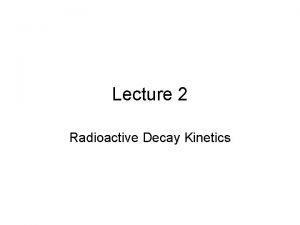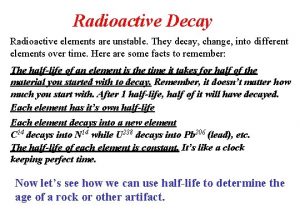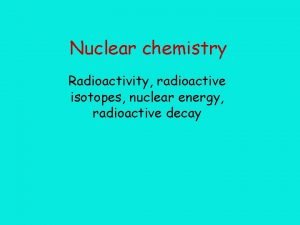RADIOACTIVE ELEMENTS Lesson 2 What are radioactive elements






- Slides: 6

RADIOACTIVE ELEMENTS Lesson 2

What are radioactive elements? • They are elements that break down forming other elements. • Their nucleus are unstable. • When the nucleus will breakdown, the element reduces, forming new element.

NOTE: • Beta particles are high energy electrons. These electrons are not electrons from the electron shells around the nucleus, but are generated when a neutron in the nucleus splits to form a proton and an accompanying electron. Beta particles are negatively charged. • Beta- is nothing but electron so you know the charge. its -e. the most important point is negative beta particles are not the orbital electrons of atom. they are produced in the nucleus. . The charge is either positive or negative. Beta Particles: β can be positrons or high speed electrons. • Ionization is the process by which an atom or a molecule acquires a negative or positive charge by gaining or losing electrons to form ions

Radiation • Radiation – a decay process where there’s an emission of energy as electromagnetic waves or as moving subatomic particles, especially high-energy particles that cause ionization.


Why are elements with atomic number 83 and higher radioactive? • Elements like to have an equal number of protons and neutrons because this makes them the most stable. Stable atoms have a binding energy that is strong enough to hold the protons and neutrons together. Even if an atom has an additional neutron or two it may remain stable. However, an additional neutron or two may upset the binding energy and cause the atom to become unstable. In an unstable atom, the nucleus changes by giving off a neutron to get back to a balanced state. As the unstable nucleus changes, it gives off radiation and is said to be radioactive. Radioactive isotopes are often called radioisotopes. • Atomic numbers greater than 83 are radioisotopes meaning that these elements have unstable nuclei and are radioactive. Elements with atomic numbers of 83 and less, have isotopes(stable neuclei; Example H-3) and most have at least one radioisotope (unstable nucleus). As a radioisotope tries to stabilize, it may transform into a new element in a process called transmutation.











